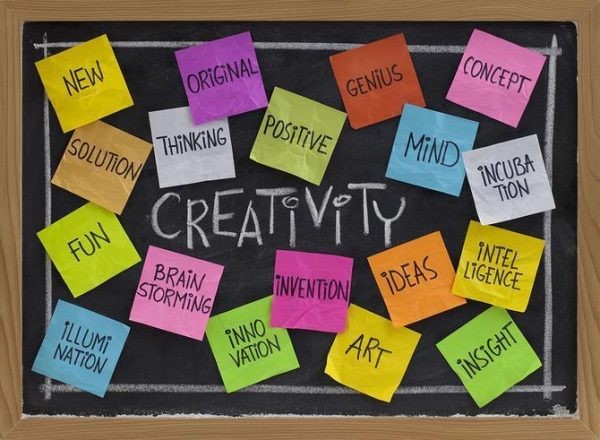In the previous blog, I labelled the Genetics Lie of Creativity the most “important” lie about creativity, putting it at #1.
And yet now I am saying there is a more damaging one. Yep!
CREATIVITY LIE #2: The Artistry Lie
“Creativity is Artistry.”
The Genetics Lie is the grandma of all the lies about Creativity, because if you believe that your Creativity is limited by your birthright, there’s no point doing anything about it at all. Even if you already consider yourself quite creative, if you can’t fundamentally improve your Creativity, it would be a waste of time and energy to try.
Yet the lie that creativity is somehow the same thing as art can do even more damage to “artists” and “non-artists” alike. It doesn’t stop you in your tracks completely, but what it does do is keep non-artists convinced that they’ll never really need to be that creative, and artists convinced that they already automatically are. On both ends, innovation is smothered and lobotomized like McMurphy in Cuckoo’s Nest, with the same poignancy of sadness at the end of the narrative.
There is a general agreement out there among many that being creative is the same thing as being artistic. Simply put it is not. Creativity is a skill, and art is a skill. They are two separate and totally distinct skills. You can be a terrific and totally uncreative painter. You can also be highly creative and stink at painting – like me in fact, and maybe like you. The two skills are completely unrelated, separate abilities, like running and javelin throwing. Yes, a decathlete happens to excel at both sports. But there are a whole lot of runners who would impale themselves on a javelin if they dared to even hold it, and not every javelin thrower is Usain Bolt.
Working on your skill as a painter, or a writer, or a post-modern multi-media innovator or whatever, is no more and no less than that: honing your craft. Malcolm Gladwell’s by-now well-known model that it takes about 10 years of steady work in any field to master it (10,000 hours with no more than 5 hours per day contributing toward that) is directed at the craft and nothing outside of it. So an artist putting in that time becomes master of their discipline, but it does not automatically mean they are now more creative than “non-artists.”
Yes, it is true that artists in training face creative challenges daily that also build their creative “muscles” (I’m still not sure how I feel about THAT metaphor but let’s go with it). Yet they also do many things, especially in the early years, like sketching live nudes or reading other people’s stories, that contribute to their mastery of their specific craft without touching on creativity much if at all.
Einstein famously said, “I have no special talents, I am only passionately curious.” Now that’s a bit of a misstatement, as Einstein certainly was not exactly mediocre in physics and mathematics abilities. Perhaps he defined the word “talent” to mean some exceptional INBORN skill, as related to Lie #1.
The important takeaway of Einstein’s quote is the distinction he makes between his skillset in science and the choice – for it is nothing but a choice – to be curious, and hence to drive toward creative. For curiosity is inarguably a core source of Creativity. Curious people seek to find new ways of doing things, and of operating outside of what’s obvious.
Creativity in essence is the ability to find innovative solutions to a problem. It does not matter whether that problem lies in art, in business, in personal relationships, or anywhere else. It seems so obvious and yet this Lie hangs out there messing up everyone’s minds. And it’s been doing so for centuries, probably ever since the common concept of “Creativity” as some kind of magic trick gained popularity during the Renaissance.
Abraham Maslow propagated the Artistry Lie in his Hierarchy of Needs by stating that only the peak of his pyramid, Self-Actualization, was a comfortable place for creative endeavors. Productive creative work, he postulated, can’t be done until the lower needs – pretty much everything else in life – have been met.

In fact, Maslow’s model seems to disprove itself. There are people who use Creativity to solve their problems at every level of the pyramid, finding innovative ways to survive, get out of poverty, find belonging, and so on.
What Maslow may have meant is that ARTISTIC activities only belong at the top of the pyramid, which maybe makes more sense, though it too is clearly not accurate. You don’t have to reach farther than Vincent van Gogh to find a striking example of an artist who spent most of his life failing at every level of the Hierarchy, yet still cranked out creative artistic work unerringly.
Maslow did have one great quote that showed he may not even have agreed with himself: “A first-rate soup is better than a second-rate painting.” In other words, creativity does, even in Maslow’s thinking, apply everywhere, even to making soup. So why did he explicitly state it only belongs to the realm of Self-Actualization? Do starving people not value good soup too?
Apparently Maslow, like so many powerful philosophers, buried himself deep in the box of thinking that artists are the truest creatives. And that’s why I call this Lie hugely damaging. Suddenly 90% of the pyramid is excluded from Creativity when in fact the lower downs might need it more than anyone.
Like the Genetics Lie, the Artistry Lie convinces you to avoid developing your creativity skills. As the list of benefits of Creativity shows, this will only dampen your work success, your happiness, and even your mental and physical health.
Next time: Creativity Lie #3.
